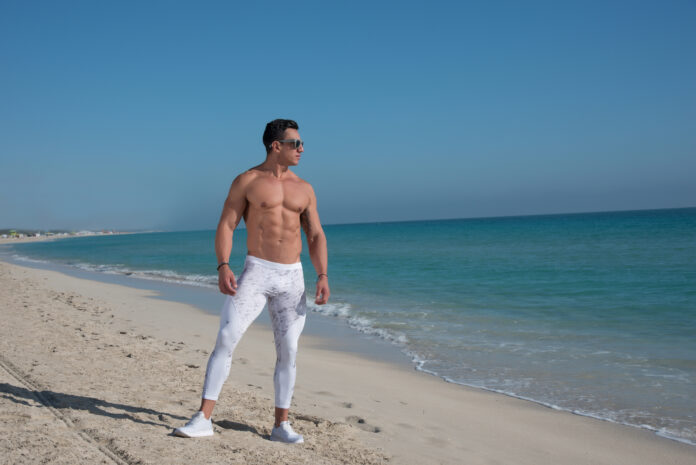Compression wear for men has become an increasingly popular choice among athletes seeking to enhance their performance and comfort during physical activities. These specialized attire, designed to snugly fit the body, apply a balanced amount of pressure to specific muscle groups. The primary idea behind men’s compression clothing is not just about fashion; it’s about providing muscular support and improving blood circulation. The use of these garments varies, ranging from professional athletes to fitness enthusiasts who desire an edge in their physical pursuits. They are made from elastic materials that allow for a range of motion while still maintaining the compression effect.
The Science of Compression Wear
The primary scientific principle behind the best compression clothing for men involves enhancing blood circulation. By applying pressure to the limbs, compression wear helps in venous return, which is the process of blood flowing back to the heart. Improved venous return ensures quicker removal of metabolic waste products like lactic acid from the muscles. This efficiency in blood circulation not only aids in increasing stamina and endurance during exercise but also plays a significant role in reducing recovery time post-exercise.
Male compression wear plays a significant role in reducing muscle oscillation during intense physical activities. When muscles vibrate, or oscillate, energy is expended, which can lead to quicker beginning of fatigue. Compression garments, such as men’s leggings and tights, provide a tight, supportive fit that limits these vibrations. This support helps in stabilizing the muscles, thereby making movements more efficient and reducing the energy loss that comes from muscle oscillation. This aspect is particularly important in sports that involve a lot of running or jumping, where muscle stability is key for peak performance.
Wearing compression clothing like leggings for men or tights for men, known colloquially as ‘meggings’, can have a notable impact on muscle fatigue and recovery times. The compression exerted by these apparels can reduce the buildup of lactic acid in muscles during exercise, which is a common cause of muscle fatigue. Moreover, the improved circulation facilitated by compression wear aids in faster removal of lactic acid post-exercise, thus speeding up recovery and reducing muscle soreness. Athletes who wear compression garments often report feeling less fatigued during their activities and experiencing quicker recovery times afterward.
Benefits of Compression Wear for Athletes

Boosting Athletic Performance
Compression wear offers a significant advantage in enhancing athletic performance. Garments like men’s compression leggings and shirts provide targeted pressure that supports muscle alignment and improves proprioception – the body’s ability to sense movement and position. This heightened awareness can lead to better form and technique, crucial factors in optimizing performance. Additionally, the snug fit of compression clothing reduces drag and improves aerodynamics for athletes, particularly in sports like cycling and running. These subtle improvements can make a considerable difference in competitive scenarios where even a fraction of a second counts.
Accelerating Recovery Post-Exercise
One of the most appreciated benefits of compression garments for men is their role in accelerating recovery post-exercise. By enhancing blood circulation, these attire help in the more efficient removal of metabolic by-products from muscle tissue. This process not only reduces the risk of Delayed Onset Muscle Soreness (DOMS) but also contributes to faster muscle repair and recovery. Athletes wearing male compression wear often report a noticeable reduction in muscle stiffness and soreness in the days following intense physical activity, enabling them to return to training sooner and more effectively.
Reducing the Risk of Muscle Strains and Injuries
Men’s tights and other forms of compression wear are not just about performance and recovery; they also play a pivotal role in injury prevention. By providing support and stability to muscle groups, compression garments can reduce the risk of strains and other muscle-related injuries. This is particularly beneficial in sports that involve repetitive and high-impact movements, where the risk of injury is elevated. The supportive nature of compression clothing ensures that muscles and joints are kept in proper alignment, thereby reducing the chances of overextension or improper movement that could lead to injury.
Athletes who integrate compression wear for men into their regular training and recovery regimes can experience significant long-term benefits. These advantages become more pronounced with consistent use, making compression garments an essential component of an athlete’s gear. They offer much more than just short-term gains, contributing to an athlete’s overall physical development and well-being.
Key long-term benefits include:
- Enhanced endurance: Continuous use improves stamina over time.
- Increased strength: Better muscle support leads to improved strength.
- Improved muscle health: Regular wear supports overall muscle well-being.
For dedicated athletes, the role of compression clothing transcends beyond immediate performance enhancement. It becomes a critical element in their broader training strategy, providing enduring benefits that positively impact their athletic journey.
Types of Men’s Compression Garments
Leggings and Tights
Among the various types of compression garments, leggings for men and tights for men, commonly referred to as meggings, are particularly popular. These garments are designed to provide compression primarily to the legs, which are key muscle groups in many sports activities. The design and material of these leggings and tights vary to suit different types of sports and weather conditions. They can be worn alone or under shorts, depending on personal preference and the demands of the sport. Not only do they offer the benefits of compression, but they also provide a layer of protection against environmental elements like sun and wind.
Compression Shorts
Compression shorts are another essential item in the male compression wear category. These shorts are specifically designed to support the thigh muscles, groin, and hamstring area. They are ideal for activities that require a significant amount of leg movement, such as running, cycling, and team sports. The snug fit of compression shorts can prevent chafing and rashes, which are common issues in endurance sports.
Compression Tops
In addition to lower-body garments, there are various styles of compression tops available for men. These include long-sleeved shirts, short-sleeved tops, and tank tops. Each style is designed to provide compression benefits to different upper body parts, including the back, shoulders, and arms. These tops can improve posture and body alignment during exercise, which is essential for preventing injuries and maximizing performance. Furthermore, compression tops can also aid in temperature regulation, keeping the body warm in cold conditions and wicking away sweat in warmer environments.
Specialty Compression Wear
For athletes involved in specific sports, there are specialty compression garments designed to meet unique requirements. For instance, compression wear for swimmers is designed to reduce drag and improve hydrodynamics, while compression gear for weightlifters might focus more on supporting core stability. Each sport has unique demands, and the design of compression wear reflects these nuances, providing targeted benefits that can enhance performance and reduce the risk of sport-specific injuries. This specialization underscores the importance of choosing the right type of compression wear for one’s specific athletic needs.
Choosing the Right Compression Wear
Selecting the right fit is essential for maximizing the benefits of compression wear for men. An appropriate fit ensures the garment performs its function without causing discomfort or restricting movement. Athletes need to carefully choose their compression wear to balance between effective compression and overall comfort.
Key considerations for selecting the right fit include:
- Tightness: Ensure the garment is snug but not excessively tight.
- Movement: The wear should allow a full range of motion.
- Sport-Specific Design: Choose garments designed for specific activities.
- Muscle Support: Check for adequate support in key muscle groups.
- Comfort: Ensure comfort, especially during prolonged use.
- Sizing Charts: Refer to sizing charts for accurate measurements.
The choice of the right compression garment involves more than just picking a size; it’s about finding a balance that suits your body and your sport. Athletes should remember that the correct fit can significantly enhance performance and reduce the risk of discomfort or injury, making it a critical aspect of their gear selection process.
Compression wear for men represents a significant advancement in athletic gear, offering a range of benefits that cater to the needs of various sports and activities. From enhancing performance and reducing injury risk to aiding in faster recovery and providing long-term muscle support, the advantages of compression clothing are clear and well-documented. As athletes continue to seek ways to improve their performance and safeguard their health, compression wear stands out as a valuable and versatile tool. It’s essential, however, to choose the right type of compression garment, considering factors like fit, material, and specific sports requirements. Embracing compression wear as part of a holistic approach to training and recovery can lead to noticeable improvements in athletic performance and overall physical well-being.









